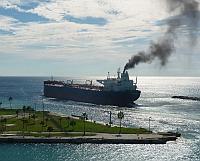 Consider these two statements:
Consider these two statements:
- Ships are the most energy efficient way to transport goods. They also have the smallest carbon footprint per ton of any means of transport.
- Ships are major polluters. One large container ship emits as much sulfur-oxide as fifty million cars.
Which statement is true? They both are. Ships are incredibly energy efficient and most large ocean going ships burn very dirty fuel. The comparison between the container ship and the cars is more than a bit unfair as the most gasoline around the world now has a very low sulfur content. In terms of other pollutants ships are cleaner than cars or trucks. Ships emit far lower CO2 per ton carried than either truck or automobiles, for example. Nevertheless, residual fuel, often referred to as Bunker C, is very dirty and highly polluting.
Recently the Environmental Protection Agency( EPA) and the US ports of New York and Los Angeles have taken steps to limit the scope and impact of that pollution. Landmark EPA regulations to reduce air pollution from ships off the East and West coasts of North America went into effect on August 1st. Ships operating in US coastal waters will now be required to burn a lower sulfur fuel. Environmental groups are pleased, while some in the cruise industry are not. As reported by Scientific American:
The North American Emission Control Area, or ECA, will reduce harmful emissions of sulfur dioxide, nitrogen oxide and particulate matter that can contribute to climate change and negatively affect the health of coastal communities. The EPA estimates that using cleaner marine fuels and engines will avoid up to 14,000 premature deaths each year by 2020 and up to 31,000 premature deaths per year by 2030.
“This is an extremely important regulation. It’s one of the most effective air pollution regulations the EPA has ever promulgated,” said David Marshall, senior counsel with the Clean Air Task Force, who participated in negotiations on the rule. “Without these regulations, these oceangoing ships burn pretty much the dirtiest fuel on the planet.”
The US now joins the Baltic and North sea regions in limiting sulfur emissions.
On a related note, the ports of New York?New Jersey and Los Angeles have both initiated programs to help reduce pollution. The Port Authority Board of New York & New Jersey’s three year, $4.9 Million Clean Vessel Initiative (CVI) program aims to encourage ship operators to reduce emissions from ocean-going vessels. The Port Authority anticipates approximately 600 vessels a year will participate in the CVI program, which will provide annual emission reductions of 182.2 tons of nitrogen oxide, 38.3 tons of particulate matter, and 264.1 tons of sulfur dioxides.
On the west coast, the Port of Los Angeles has developed the Environmental Ship Index (ESI), an international clean air programme that rewards ocean carriers for bringing their newest and cleanest vessels to the port. Six major shipping lines; Evergreen, Hamburg Süd North America, Hapag-Lloyd, Maersk Line, Nippon Yusen Kaisha and Yang Ming have signed on to the programme and will begin receiving incentives later this year.
“We applaud these early adopters of the ESI program and encourage not only other carriers to participate but also other ports to join this global port program,” said Geraldine Knatz, executive director of the Port of Los Angeles.
“Growing participation among ports worldwide will increase the level of incentives available to ship operators that invest in and deploy the cleanest, most efficient and environmentally friendly fleets.”
